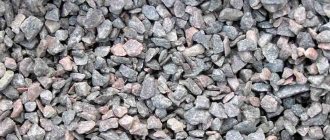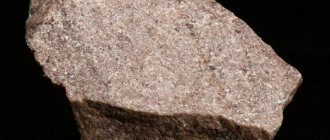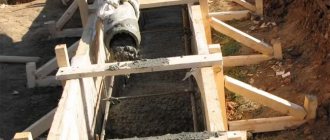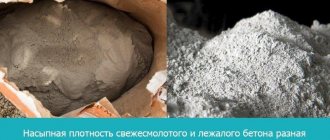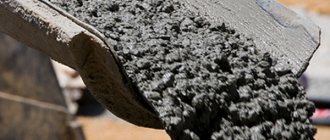To correctly calculate the composition of mortar and concrete, technical indicators such as bulk density and specific gravity of cement are used. The consumption of the binder component and, ultimately, the strength of foundations, walls, partitions, and monolithic reinforced concrete frames depend on the magnitude of these values.
If the specific gravity is a relatively constant value and depends on the brand of cement, then the bulk density can have different values depending on the fineness of grinding, shelf life, method and duration of transportation.
How many liters are in 1 cubic m?
In the metric system of measures: 1 m³ = 1000 dm³ = 1,000,000 cm³ = 1,000,000,000 mm³ = 1,000 liters. When converted to other units: 1 m³ ≈ 35.3 cubic feet ≈ 1.31 cubic yards ≈ 6.29 barrels.
Interesting materials:
How to make Undertale full screen? How to make Android louder? How to make English the default language in Windows 10? How to make English the default? How to make English the default input language? How to make English on a laptop? How to make an English keyboard in Google? How to set English keyboard layout as default? How to animate text in PowerPoint 2007? How to make antiseptic at home?
Bulk density of cement
Before each preparation of a concrete mixture or solution, it is necessary to determine by calculation the actual bulk density of cement (BCD), since it can differ significantly from the average indicators. This will allow you to more accurately calculate the proportions of the components. The actual NPC shows the ratio of cement weight to volume, taking into account the presence of voids between its particles. It is measured in kilograms per cubic meter (kg/m³). Existing varieties of cement have different average bulk density values.
| Types of cement | Bulk density, kg/cm³ |
| Portland cement | 1100-1300 |
| Slag Portland cement | 1100-1250 |
| Pozzolanic | 800-1000 |
| Aluminous | 950-1150 |
In construction, the most commonly used Portland cement is CEM 32.5 (M400), CEM 42.5 (M500) with a bulk density of 1200 and 1300 (kg/cm³), respectively. The presence of additives may slightly increase this value. To accurately calculate the proportions of a concrete mixture before using it, it is necessary to determine the actual NPC, especially if it has been stored for a long time.
To do this, you can use a cylindrical measuring vessel with a volume of 1 liter. It must be pre-weighed and filled with cement using a funnel and spatula. The slide is removed with a steel ruler. Compacting or shaking the contents is not allowed.
The filled cylinder is weighed on a laboratory balance. The mass of the vessel is subtracted from the result. The resulting value is divided by the volume of the cylinder. The end result is the actual bulk density of the cement.
Proportion calculation
Correctly calculated proportions are very important for kneading the mixture. They directly depend on the brand of concrete they want to obtain. The rule applies here: to obtain a specific grade of concrete, you need to take cement of a grade twice as high. That is, if M200 concrete is needed, then it requires the use of M400 cement. Accordingly, concrete grade M250 is M500 cement.
But this does not mean that M500 cement is suitable only for such concrete. It can also be used to prepare a solution of a different brand, only the proportions will be different. For calculations, you can use ready-made proportions that are found in reference literature.
For example, from M500 cement you can prepare mixtures with the same volumetric composition as shown in the table.
| Concrete grade | Cement consumption per 1 cubic meter concrete, kg | Volume of cement for the production of 1 cubic meter of concrete, l | Volumetric composition of sand and crushed stone per 10 liters of cement |
| M100 | 111,0 | 166,0 | 53,0/71,0 |
| M150 | 137,0 | 205,0 | 40,0/58,0 |
| M200 | 161,0 | 241,0 | 32,0/49,0 |
| M250 | 200,0 | 300,0 | 24,0/39,0 |
| M300 | 213,0 | 319,0 | 22,0/37,0 |
| M400 | 278,0 | 417,0 | 14,0/28,0 |
| M500 | 313,0 | 469,0 | 12,0/25,0 |
Thus, the higher the grade of concrete, the more cement you will need and the less sand and crushed stone you will need.
Theoretically, in the absence of M500 cement, the M400 composition can be used. Its strength is slightly less, but it can still withstand high loads. However, if the grade of cement is lower than required according to the instructions, the amount of material should be increased by approximately 15% compared to the proportions indicated in the table.
When purchasing sand, its fraction is taken into account. If it is less than required by the rules, then the amount increases by 10%. The same rule applies to crushed stone if you have to replace it with gravel.
Features of the mixture
Scheme of a wall made of blocks with cladding.
So, concrete has several varieties that differ in weight. Basically, when performing monolithic operations, cement concrete is used, with an average weight of 2300-2500 kg / cubic meter.
The light variety is usually used in the form of ready-made blocks (wall).
In order to produce a high-quality solution, you cannot use a sand-gravel mixture or pgs. Theoretically, a solution from PGS will work, of course, but it is almost impossible to establish the exact ratio of sand and gravel in PGS. As a result, there is a high risk of getting low-quality material.
Because it is absolutely impossible to know in advance what brand of PGS will come out, how much of the necessary ingredients need to be added there, and how it will behave during use.
Unscrupulous manufacturers sometimes use PGS during production, which is why you need to be extremely careful and periodically look at the site where crushed stone and sand are stored. You can also inspect the quality of the cement.
Comparison of the structure of foam and gas blocks
So, according to the type of binder they are divided into:
- Silicate.
- Made from cement.
- Polymer concrete.
- Plaster, etc.
The basic method for calculating the required amount of sand concrete mortar
- a special chemical substance that has high strength and astringent properties - first grade Portland cement;
- sand with a fraction size of no more than 3 millimeters;
- plasticizers, which have the properties of increasing moisture resistance and strength of building materials;
- In order to improve the properties, granite powder is added to the solution.
How many bags of sand concrete are in 1m3? The mixtures are sold in prepackaged packages weighing 25, 40 and 50 kg. This building material is a type of heavy concrete, for this reason the mass of one m3 is approximately 2.4 tons. Using special calculations, when the consumption of sand concrete is 20 kg per 1 square meter, with a layer thickness of 1 cm, then the quantity is calculated using the following formula:
- the volume of a forty kilogram bag is divided by 20 kg, resulting in 2 cm. In order to process 100 cm/2 cm of area, 50 bags will be needed;
- if the volume is 50 kg, then in order to treat an area of 1 m2 you will need 40 packages.
Before determining the required amount of sand concrete per 1 m3 of solution, it is recommended to take into account the condition of the surface layer, the required mixture proportions and the thickness of the coating.
It is recommended to determine this using the following parameters: 1 m3 of sand concrete has a weight of 2400 kg, which must be divided by the package weight of 40 kilograms. The total is:
- 0.010 cubic meters in a 25 kg sand concrete bag;
- 0.017 cubic meters in a 40 kg sand concrete bag;
- 0.021 m3 per 50 kg package.
- 2.4 g/cm3;
- 2.4 t/m3;
- 2400 kg/m3.
Working with the M150 requires compliance with certain rules. But they are no different from the procedure for using other building mixtures of this type.
We invite you to familiarize yourself with roofing felt for foundation waterproofing: features and choice
If this is a wall, then it must be completely freed from dust and dirt, plant debris, etc.
Cleaning the wall
Removing old plaster
But for this it needs to be prepared. For plastering walls, the proportion is as follows: for 10 kg of M150, 2 liters of water. It is advisable to take it clean and cold, but not very cold, about 15 C. If necessary, you can add more liquid.
The solution is made like this. The mixture (dry) is gradually added to the water and mixed. When the mass becomes homogeneous, let it stand for about 5 minutes. And then it must be quickly mixed again. The batch should be worked out within 2 hours.
Preparing the mixture
When applying plaster to the surface, it is necessary to cover all cracks and holes, if any, with it. And only after that level the entire surface. As a rule, the solution itself is applied with a spatula and leveled with a grater.
Application with a spatula
Application to reinforcing mesh
M150 is considered a universal brand among similar cement-sand mixtures. It behaves well during various technological operations. This mixture, if necessary, can replace any other. That is why it is in demand in the construction market.
Cement bag volume
In general, the question of how much cement is contained in a bag is not so easy to answer. Let's start with the fact that packaging comes in bags of 25 kg, 40 kg and 50 kg. So we need to clarify the mass. The second point is that cement comes in different forms. With or without additives. And additives also come in different types, and different types differ in density. This means that the same weight occupies a different volume.
The weight of a bag of cement can be 25 kg, 40 kg and 50 kg
There is one more point. The density of any cement changes over time. Immediately after production, when it was poured into bags, the density is the lowest. As the ground powder is poured in, the particles become charged and capture air molecules. Therefore, freshly poured it weighs less. During transportation and storage, the charge decreases, some of the air evaporates, and the density increases. So after a month more weight is placed in the same volume. Moreover, after about a year of storage, the difference with the bulk density is significant - up to 35% of the original value.
In the calculations, an average figure is taken, which is called specific density. For each type of cement it is different and in calculations when determining the amount of material required, you can build on it.
Calculation method
The specific density of cement is the mass of one cubic meter. For Portland cement, for example, it is 1300 kg/m³. To determine the volume of cement in a 50 kg bag, you need to solve a simple proportion:
How to calculate the volume of cement in a bag
We found what percentage of one cubic meter is contained in one 50 kg bag of Portland cement. This is 3.85%. This means that this container contains 0.0385 m³ (we simply “take a percentage” of the cubic meter).
Pivot table
For a bag of 25 kilograms, you can not count, but divide the resulting figure by two. One 25 kg bag of Portland cement contains 0.019 m³. For a 40 kg bag, you will have to calculate everything again. The result is 0.031 m³. Similar calculations must be done for all brands of cement with different densities. We did this and compiled the data into a table.
Why know the weight of a cube of cement?
In stores, cement is sold packaged in 25 kg or 50 kg bags, and the proportions of concrete, plaster, and mortar are given in volume fractions. That is, components must be measured not by weight, but by volume, and this is where the difficulty lies. That is, you need to know how many kg of cement are in 1 m³, or buckets in a bag, how many kilograms of the same cement are in a bucket, etc.
Table of cement consumption in kilograms per cubic meter of mortar of different brands
It’s easier with buckets, since you can determine experimentally how many buckets of cement are in one bag. We bought one bag of binder, poured it into buckets, and counted the quantity. When pouring the bucket, we don’t shake it, we don’t compact the binder in any way. In general, everything is simple. This will not work with a cubic meter.
How to prepare concrete with the required characteristics
One of the quite important characteristics of any concrete is its mobility. In this regard, the less cement there is in the mass of components, the higher this indicator will be.
Otherwise, if the binder is not added, there is a risk that all the ingredients will not stick together properly.
In this case, just one season can become fatal: wind, sun and humidity will begin to destroy the building. That is why it is very important to use exactly the amount of cement that is considered correct.
To prepare concrete with the required characteristics, the error in the amount of binder should not exceed one kilogram.
At the same time, this figure relative to crushed stone is much higher - up to five kilograms. It is best not to go beyond these boundaries, since then the building mixture will not turn out as previously expected.
The brand of cement should be chosen in relation to what the brand of future concrete will be. These material parameters are interconnected and influence each other. It is believed that the optimal concrete mixture will be obtained when the grade of cement used is at least twice the grade of the prepared mortar.
This means that if concrete grade M200 is needed for walls, it is best to choose a binder grade M400 or higher.
For more information on how to prepare a concrete mixture, watch the video:
A few words about strength
In recent years, cement has been used in grades M400 and no lower, despite the fact that it is more expensive. The usual argument is that manufacturers claim greater strength than it actually is. Maybe so, but keep in mind that the manufacturer guarantees the declared strength for 2-3 months from the date of production. So when purchasing, pay attention to the “freshness” of the binder. During storage, the strength of cement decreases, noticeably:
- after 3 months it becomes 20% lower;
- after 6 months of storage it decreases by 30%;
- after a year the strength drop is 50%.
So buying cement for future use is not a good solution. If you have a stale one, when kneading the quantity should be increased by 2-4 times, depending on the shelf life. It is also advisable to add hardening accelerators to the composition. Since, in addition to loss of strength, long-term storage greatly increases the hardening time. That is, concrete gains strength very slowly.
The same grade of concrete can be obtained using different grades of cement
So you should not buy cement packaged in building materials warehouses, because it is not clear when it was produced. If Portland cement is packaged at a factory, the date is immediately stamped. It's easy to navigate here. It is unknown how long the cement remained in the warehouse. Even if they put a packing date, it doesn’t give us anything. So, we are looking for factory packaging with the production date.
The second point that forces the use of high-quality cements is that they gain strength faster than low-quality ones. For example, concrete made from Portland cement M500 will gain 50% strength in just 3-4 days (at a temperature not lower than +20°C and sufficient humidity). When using the M400 brand under the same conditions, you have to wait 7-8 days for 50% of the strength. If you're under deadline pressure, this may be more important than a higher price.
Source
Requirements for concrete mixture components
In the process of making concrete, it is very important to focus on certain indicators of the properties and characteristics of the components of the material.
First of all, it is necessary to monitor the weight of all ingredients - cement, sand and crushed stone (or gravel).
The ratio of these concrete elements should be clear - 1: 3: 5, respectively. If the proportions are violated, the source material can significantly lose its indicator values.
Concrete composition
For cement, it is worth noting some periods of its operation.
It must first be active to allow time after the concrete has been prepared before it can be used. After this, it is important to pay attention to the period of hardening and strength gain.
Cement
As for sand, such a parameter as voidness is important for it. It implies the presence of certain air gaps between the particles of the material. Also, any sand has its own density and a certain amount of moisture.
This parameter does not significantly affect the ratio of sand to other components, but may require reducing or adding the amount of water to the solution.
It is best to select sand with low levels of organic additives and clay compounds.
Sand
They are bad for preparing concrete. This is due to the fact that clay can create small conglomerates, and organic matter can react with additives in cement.
Crushed stone must also be as clean as possible and without any impurities. It, like sand, can first be sifted for cleaning. Strength and structure are two main indicators of crushed stone that are worth paying attention to.
Crushed stone
Specific Gravity
It is calculated without taking into account the air between the particles, so its value is higher than that of bulk. This characteristic is used as an applied value, used in calculating the composition of components for the preparation of cement mortars and concrete.
Its value depends on the fineness of grinding of the binder component, the presence of chemical and active additives. Determined in a laboratory using special equipment. It is a constant value for each type of cement and amounts to 2700-3500 kg/cm³.
| Types of cement | True specific gravity, kg/cm³ |
| Portland cement without additives | 3150 — 3500 |
| Slag Portland cement | 2950 — 3050 |
| Sulfate-slag | 2850 — 2950 |
| Portland pozzolanic cement | 2750 — 2950 |
| Sulfate-resistant pozzolanic Portland cement | 2700 -2800 |
| Aluminous | 3050 — 3100 |




